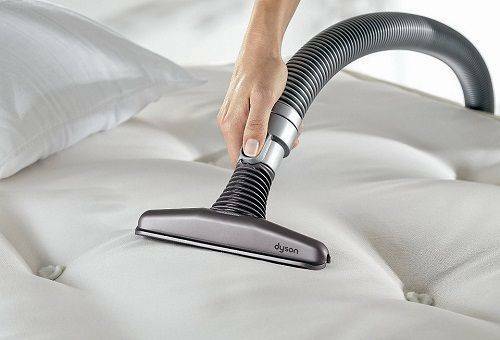The average cleaning of mattresses is carried out not more often than 1-2 times a year, and usually the procedure is limited to using a vacuum cleaner. If the product needs to be cleaned more thoroughly, for example, to get rid of traces of urine and the characteristic unpleasant smell, not only physical and mechanical variants of action go into play, but aggressive chemical reagents.

The complexity of the approach is that even if it is possible to remove stains from the surface of the material, removing the liquid that has permeated the inner layers of the mattress is not so simple. In some cases, only cleaning done by professionals helps, but first you should try to clean the product at home.
Important rules in the care of a mattress, which are often neglected
Profile processing, capable of removing stains from urine from the surface of the mattress, will help only if the fabric itself is not covered with a layer of dust or greasy plaque. The lack of proper regular maintenance of a functional object affects its condition and in some cases greatly complicates the cleaning process. In these cases, the only solution is dry cleaning.

To clean the product fabric and its filler from dust, grease, mold and dust mites, the following manipulations must be carried out regularly:
- A detergent vacuum cleaner or steam cleaner is ideal for dust collection. It not only provides surface treatment of the mattress, but also helps to get rid of ticks, restores the product freshness.
- Cleaning of the tissue from spilled beverages, traces of food and other resistant ridge should be carried out with special stain removers. Means for processing furniture with fabric upholstery will cope with these problems no worse than dry cleaning
. Tip: Wash the product is not recommended under any circumstances. If the situation is such that the functional device is soiled very often and it takes a lot of time to clean it, then it is better to wrap it with a thin polyethylene. In this case, traces of urine, an unpleasant smell and dirt will need to be output only with a sheet.

- Fat and grease stains are most easily removed with the help of ammonia or ethyl alcohol. It is necessary to simply rub the contaminated area and allow it to dry out.
- With traces of mold, which often appears with regular urine on the mattress and its subsequent processing, a weak vinegar solution works well. The surface is cleaned, and then dried in the sun.
When working with spots of uncertain nature, do not take risks, using highly specialized tools. Before you get rid of the formation, it needs to be sprayed with a mild soap solution from the spray gun and covered with a tissue from a well absorbent fabric. The problem either goes away, or gives a specific smell, through which it will be possible to establish the nature of the contamination.
Means that will help to quickly remove traces of urine from the mattress
Cleaning the product with the formation of urine spots on its surface should be carried out immediately. If the liquid dries, get rid of the effects in the form of a persistent odor will be difficult.

Dry cleaning is not useful if you act according to the following scheme:
- Fresh, still damp spots need to be cleaned with a foam solution of liquid soap or dish detergent. We apply the foam directly to the contamination and after a few minutes we remove the moisture with dry napkins.
- A fresh stain can be cleaned with a gruel made from lemon juice( but not dilute acid) and shallow salt. The resulting mixture rubbed the problem place on the mattress and wait at least two hours. Then we collect the remains of the composition, which absorbed moisture and odor, with dry napkins.
- The vinegar solution helps to get rid of the persistent aroma no worse than dry cleaning. For a glass of water, take two tablespoons of vinegar. Spray the product over a stain or rub it directly into the area from which an unpleasant odor emanates. It is not necessary to clean it, we just wait until the fabric dries. If necessary, we make one more approach.

After the surface has been cleaned of unwanted formations, the product must be ventilated in fresh air. The best effect is the hang of the product in the frost. In the summer, the problem zone can be hung or dipped with dry ice cubes wrapped in permeable fabric.
